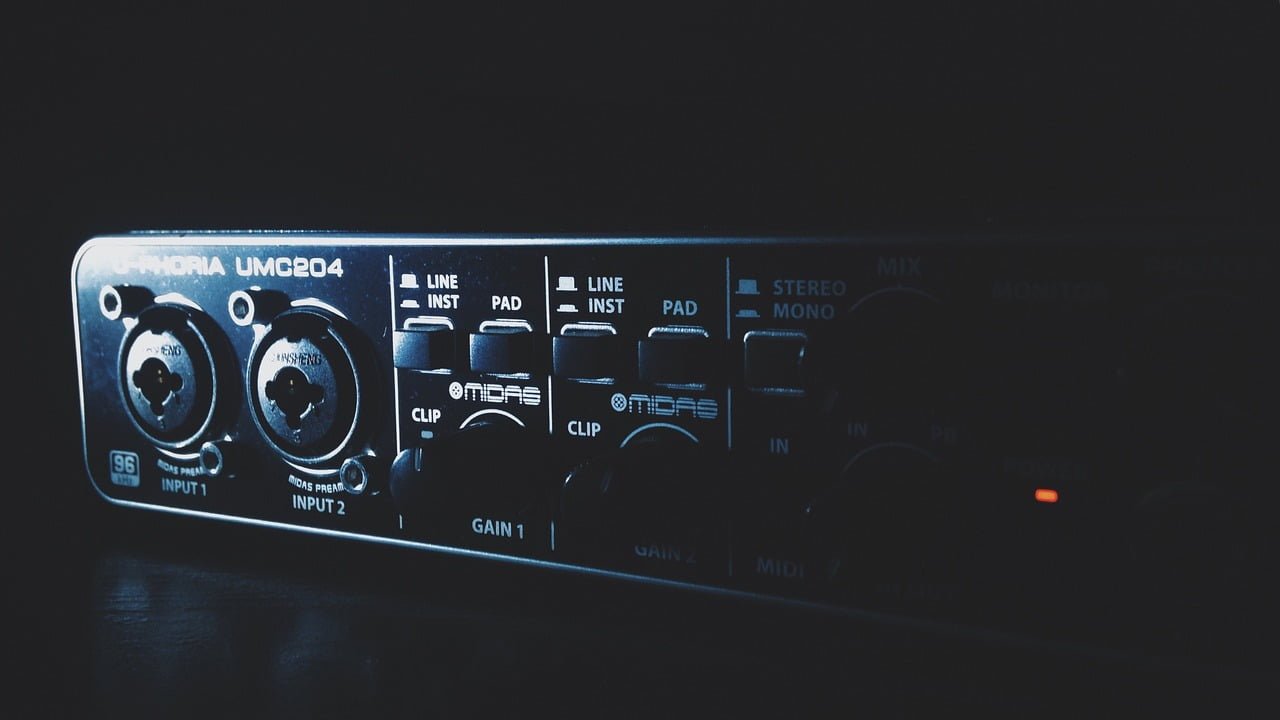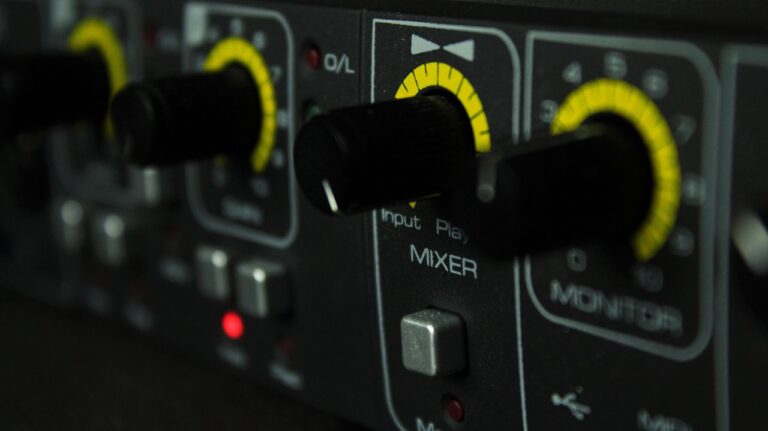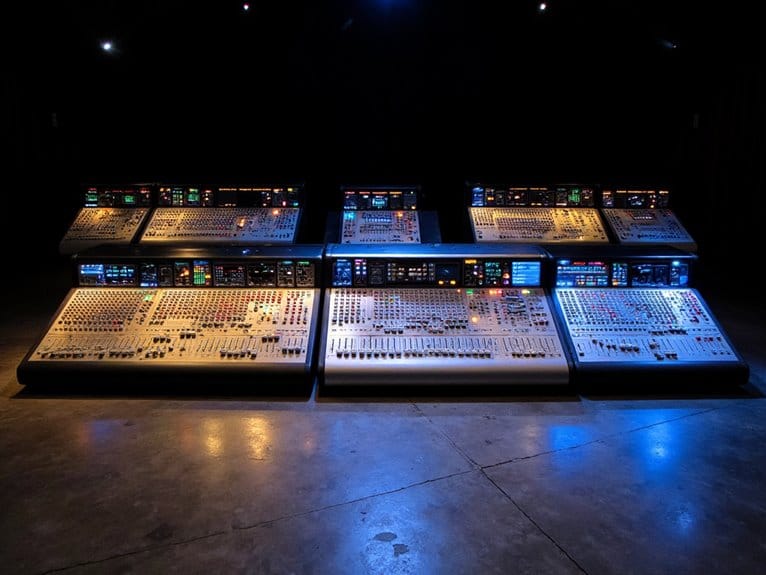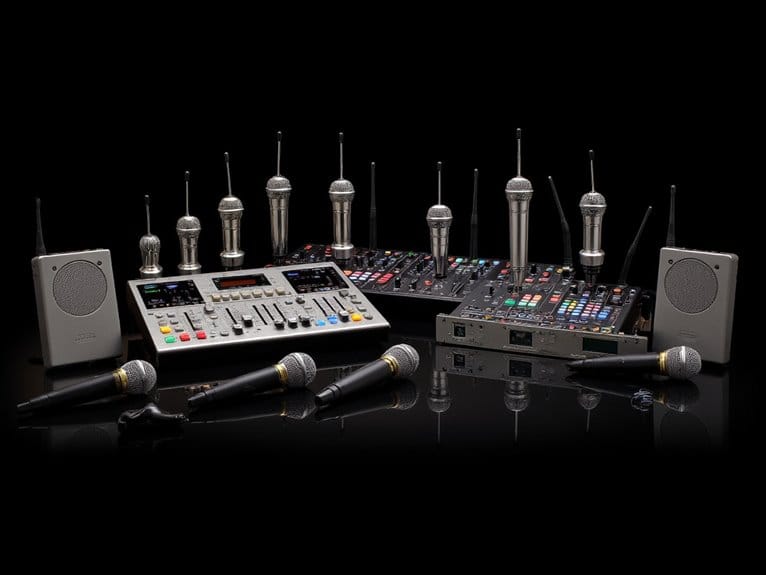The Ultimate Guide to Selecting the Best Audio Interface
When selecting the best audio interface, I focus on achieving pristine sound quality by considering factors like converters, preamp noise levels, and dynamic range for ideal signal cleanliness and capturing sound levels. Checking for driver availability, compatibility with older gear, and connectivity options like ADAT or S/PDIF ports guarantees seamless integration with existing equipment. Considering inputs like mic, line, and MIDI for diverse connections, and outputs like TRS, ADAT, and RCA for efficient signal routing, enhances the audio interface’s versatility. Paying attention to data transfer speeds, such as Thunderbolt for fast rates, USB for wide compatibility, or PCIe for high-speed capabilities, is essential for selecting the ideal interface. Finally, user satisfaction through clear audio output, minimal distortion levels, and balanced inputs/outputs is key, pointing towards a detailed guide to making the best audio interface choice.
We are supported by our audience. When you purchase through links on our site, we may earn an affiliate commission, at no extra cost for you. Learn more.
Importance of Sound Quality
Achieving pristine sound quality is essential when selecting an audio interface for professional recording and playback purposes. The audio interface serves as the bridge between the analog and digital worlds, where sound quality is of utmost importance. Key elements that greatly impact sound quality include the quality of converters, preamp noise levels, and dynamic range. High-quality A/D and D/A converters are vital for accurately translating analog audio signals into digital data and vice versa without introducing distortion or coloration. Lower preamp noise levels guarantee a cleaner signal path, minimizing unwanted noise during recording.
Furthermore, the dynamic range of an audio interface is crucial for capturing the full spectrum of sound levels, from the quietest whispers to the loudest peaks, without losing detail or introducing noise. Higher bit depths and sampling rates contribute to better audio quality by capturing more nuances and details during recording and playback. Balanced connections help reduce interference and noise, providing clear and distortion-free audio signals.
When considering input and output options, having a variety of choices allows for greater flexibility in connecting various audio sources and devices. Opting for an audio interface with high-quality components and design considerations is essential as it ensures that every step of the audio signal chain maintains integrity and fidelity, resulting in optimal recording experiences.
Compatibility With Existing Equipment
When ensuring compatibility with existing equipment for an audio interface, it is important to verify the interface manufacturer’s website for detailed information on supported microphones, instruments, and studio gear.
- Check for Driver Availability: Make sure that the necessary drivers are available and up to date to guarantee seamless integration with your current setup.
- Research Compatibility with Older Gear: Compatibility issues might arise with older gear or specific software configurations, so thorough research is essential.
- Additional Cables and Adapters: Some interfaces may require extra cables or adapters to connect to certain equipment, so ensure you have what you need.
- Connections Matching Existing Devices: Verify that the interface’s connections align with your existing devices to prevent compatibility issues during recording sessions.
- Compatibility with Studio Gear: Confirm that the audio interface is compatible with your studio gear such as monitors, mixers, and outboard gear for a smooth workflow.
Expandability and Future-Proofing
When considering expandability and future-proofing in audio interfaces, it’s important to look for connectivity options like ADAT or S/PDIF ports to easily add more inputs as needed. Selecting an interface with ample channels guarantees flexibility for potential growth in your recording setup, catering to evolving needs. Interfaces with digital I/O options such as AES/EBU or Dante provide increased compatibility with professional audio systems, enhancing your connectivity possibilities for advanced recording configurations.
Connectivity Options for Versatility
Considering the expandability and future-proofing of your audio interface setup, examining the available connectivity options is crucial for seamless integration with existing equipment. Here are key connectivity options to enhance versatility:
- Thunderbolt: Offers fast data transfer rates, ideal for low latency and high-resolution audio.
- ADAT optical inputs: Enable expanding input/output channels by connecting additional preamps or converters.
- PCIe interfaces: Provide professional-grade connectivity with fast data transfer rates for demanding studio setups.
- Digital I/O options: Future-proof your setup with compatibility for evolving audio gear using options like S/PDIF or AES/EBU.
- Seamless Integration: Selecting the right connectivity ensures flawless integration, maximizing the versatility of your audio interface setup.
Compatibility With Upgrades
To guarantee seamless integration of future upgrades and expandability, prioritize selecting an audio interface that offers versatile connectivity options and expandable features. Look for interfaces with ADAT capabilities, allowing you to add more inputs as your setup grows. Ensuring compatibility with evolving recording needs, choose an interface that supports firmware updates for upcoming software upgrades. Verify that the interface is compatible with the latest operating systems to prevent any issues with future updates. Opt for an interface that provides room for growth, accommodating your expanding requirements over time. By selecting an interface with these key features, you can future-proof your setup and adapt to changes in technology and software upgrades effortlessly.
Consideration of Inputs and Outputs
When selecting an audio interface, understanding input types is essential for determining compatibility with microphones, instruments, and other gear. Exploring output connections is important to guarantee proper monitoring through headphones, speakers, and other audio devices. Signal routing options play a crucial role in directing audio from inputs to outputs efficiently within the recording environment.
Input Types Overview
In audio interfaces, a variety of input types, including mic inputs, line inputs, optical inputs, DI inputs, and MIDI inputs, facilitate the connection of diverse audio sources.
- Mic inputs: Allow for connecting microphones directly to the interface.
- Line inputs: Ideal for connecting devices with line-level outputs like keyboards or mixers.
- Optical inputs: Enable digital connections for devices like ADAT expanders.
- DI inputs: Perfect for plugging in instruments like guitars directly.
- MIDI inputs: Used for connecting MIDI controllers or instruments for digital music production.
Output Connections Explained
With various output connection options available on audio interfaces like RCA, TRS, and digital outputs, understanding their characteristics is essential for optimizing signal transmission and compatibility with audio equipment. TRS outputs are commonly utilized for balanced connections, reducing interference and preserving signal integrity in professional setups. Digital outputs such as ADAT and S/PDIF provide increased channel counts and connectivity to external devices, enhancing recording capabilities for advanced users. On the other hand, RCA outputs are often employed for unbalanced connections, suitable for simpler consumer audio setups. Knowing the distinctions among these output types is vital for efficient signal routing and ensuring seamless integration with studio monitors, headphones, and other audio gear.
Signal Routing Options
Considering the diverse needs of audio production setups, the selection of signal routing options plays an essential role in maximizing the functionality and efficiency of an audio interface. When selecting an interface, it is crucial to take into account the number of inputs needed for simultaneous recording of vocals, instruments, and more. Additionally, assessing the outputs is important, including multiple headphone outputs, line outputs for studio monitors, and digital outputs for external processing units. Some interfaces offer ADAT-equipped options for expanding input/output capabilities, while others feature Legacy Mode for compatibility with older gear. The price point of an interface often reflects the available signal routing features, making it important to balance functionality with budget constraints.
Comparison of Connectivity Options
When comparing connectivity options for audio interfaces, it is important to consider the data transfer speeds and compatibility of each connection type. Thunderbolt stands out for its faster data transfer speeds, making it the ideal choice for professional audio interfaces that demand high performance. USB, on the other hand, is commonly found in home studio interfaces due to its widespread compatibility and ease of use. PCIe connections provide another option for professional audio interfaces requiring maximum performance, offering high-speed data transfer capabilities.
In recent times, Thunderbolt has gained popularity in semi-pro interfaces because of its high-speed capabilities and low latency, making it a promising choice for users seeking a balance between performance and cost. Checking computer compatibility is essential when selecting an audio interface based on the type of connector used. This ensures that the chosen interface will work seamlessly with the existing setup, avoiding any compatibility issues that may hinder peak performance.
Considering these connectivity options based on data transfer speeds, compatibility, and intended use (whether for home studios, semi-pro setups, or professional studios) is important when selecting the best audio interface for your specific needs.
Factors for User Satisfaction
User satisfaction with audio interfaces is greatly influenced by the sound quality, signal-to-noise ratio, and support for high-resolution audio formats. When considering factors for user satisfaction, several key elements come into play:
- Compatibility: Ensuring seamless integration with existing equipment and software is essential for a positive user experience.
- Clear Audio Output: Users expect crisp, distortion-free audio output for accurate monitoring and recording.
- Minimal Distortion: Low distortion levels are critical for maintaining the integrity of the audio signal.
- Balanced Input/Output: Having balanced inputs and outputs helps in reducing noise and interference for cleaner audio signals.
- Size and Expandability: The size of the audio interface and its expandability options are important considerations based on the user’s setup and future needs.
Considering factors like DSP capabilities, expandability, and user feedback can aid in making an informed decision when selecting an audio interface. User satisfaction is not only dependent on technical specifications but also on how well the interface meets the user’s specific requirements and expectations.







